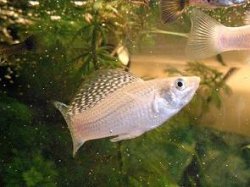Hi everyone, im new to this site and have a problem with my molly. About a month and a half ago i purchased two silver mollies. The female was pregnant. She gave birth and a few weeks later all the fry started to die , one by one, each day. After that the female molly has never sucessfully mated and is not pregnant. Mostly every morning, they try to mate but the male justs gets bored and drifts off. Suggestions would be most appreciated.
You are using an out of date browser. It may not display this or other websites correctly.
You should upgrade or use an alternative browser.
You should upgrade or use an alternative browser.
Molly Mating Problem
- Thread starter ak>47
- Start date
if the fry started deing a couple of weeks after they were bron, then it is probably a disease or water quality that killed them. Were the fry kept in the same tank as the adults, or were they in a new tank just for them?
If they were in a new tank it was probably ammonia in the water that killed them. Ammonia is produced by anythign that breaks down in the water, ie: fish food and waste. If their tank did not have an established biological filter running on it, then the ammonia levels would go up and kill the fry.
It's unusual for a male livebearer (molly) to give up trying to breed with a female. However, if the female is sick then the male might ignore her. Otherwise the female could be pregnant and that will also stop most males from trying to breed with her.
If you can post a pic of the fish and perhaps give us some more details about the tank, we might be able to offer more help.
how big is the tank?
how long has it been set up for?
how often do you do water changes and gravel cleans?
how often do you feed the adult fish and the fry?
have you tested the water for ammonia, nitrite, nitrate & pH?
If they were in a new tank it was probably ammonia in the water that killed them. Ammonia is produced by anythign that breaks down in the water, ie: fish food and waste. If their tank did not have an established biological filter running on it, then the ammonia levels would go up and kill the fry.
It's unusual for a male livebearer (molly) to give up trying to breed with a female. However, if the female is sick then the male might ignore her. Otherwise the female could be pregnant and that will also stop most males from trying to breed with her.
If you can post a pic of the fish and perhaps give us some more details about the tank, we might be able to offer more help.
how big is the tank?
how long has it been set up for?
how often do you do water changes and gravel cleans?
how often do you feed the adult fish and the fry?
have you tested the water for ammonia, nitrite, nitrate & pH?
I had the baby mollies separately in a net breeder, in a separate tank. I only did the wawter changes every two weeks, so i think your right, the ammonia did kill them.
With regards to the adult mollies, none of them have caught a disease. The females has not been pregant for two months now, and has only bee pregnant after the first batch of fry. They are very active and don't show any signs of ill health. Would you suggest i get another male molly cause his breeding skill dosnt seem to be normal.?
Anyway, my tank is 50 litres (30x60x30) and has been set up 4 months ago. I do weekly water changes, and feed them two times a day. I have tested the tank for amonia and nitrate and ph. Currently amonia and nitrate are close to 1 and ph is at 8.0
With regards to the adult mollies, none of them have caught a disease. The females has not been pregant for two months now, and has only bee pregnant after the first batch of fry. They are very active and don't show any signs of ill health. Would you suggest i get another male molly cause his breeding skill dosnt seem to be normal.?
Anyway, my tank is 50 litres (30x60x30) and has been set up 4 months ago. I do weekly water changes, and feed them two times a day. I have tested the tank for amonia and nitrate and ph. Currently amonia and nitrate are close to 1 and ph is at 8.0
You want the ammonia and nitrite to be 0 and the nitrate to be as low as possible. Ammonia is very toxic in alkaline water and if the pH is 8.0 then a tiny amount would be enough to kill the fry and possibly even affect the adults.
The male molly is probably fine but if the female has intestinal worms, that will stop her from becoming pregnant again. Livebearers are usually riddled with intestinal parasites (worms) and they take a big toll on the fish. Perhaps try de-worming the fish and see what happens after that.
Flubenol is a good wormer if you can get if. But it depends on where you are located as to what medication you should use.
The male molly is probably fine but if the female has intestinal worms, that will stop her from becoming pregnant again. Livebearers are usually riddled with intestinal parasites (worms) and they take a big toll on the fish. Perhaps try de-worming the fish and see what happens after that.
Flubenol is a good wormer if you can get if. But it depends on where you are located as to what medication you should use.
im dont think its intestinal worms because i've never seen the mal successfully mate with her. She always allows herself to become available but the male just dosnt do it properly. But thanks, anyway i will try that worm medication in addition.
Thanks
Thanks
the only reason I could think of as to why the male is unable to breed with the females, would be if his gonopodium (breeding tube/ anal fin) was excessively long. It happens in longfin swordtails where the gonopodium is too long and cannot be used properly by the males. Having said that, female livebearers can carry sperm packets from previous matings. They use these sperm packets to fertilise successive batches of eggs if there isn't a male around. If the female was in a community tank with other males before you got her, then she might have some left over from an earlier mating and she should be able to use these. However, if she has used them all up then nothing will happen.
Do you have a picture of the male?
Do you have a picture of the male?
the only reason I could think of as to why the male is unable to breed with the females, would be if his gonopodium (breeding tube/ anal fin) was excessively long. It happens in longfin swordtails where the gonopodium is too long and cannot be used properly by the males. Having said that, female livebearers can carry sperm packets from previous matings. They use these sperm packets to fertilise successive batches of eggs if there isn't a male around. If the female was in a community tank with other males before you got her, then she might have some left over from an earlier mating and she should be able to use these. However, if she has used them all up then nothing will happen.
Do you have a picture of the male?
Here are some pictures and im really not sure if his gonopodium is too big

 [attachment=55
[attachment=55888
 ANY0080.JPG]
ANY0080.JPG]Attachments
The male is a normal silver molly and should be able to do the job without any problems. Physically he looks fine.
The fish that have trouble breeding usually have a gonopodium about 2-3 times as long as his. It can almost reach the tail and the fish are unable to use them properly. But your male looks normal so I would say it could well be the female.
Try de-worming the tank and if there aren't any young a couple of months later, then swap the male. But only have one male in the tank because they argue and will harass the female.
The fish that have trouble breeding usually have a gonopodium about 2-3 times as long as his. It can almost reach the tail and the fish are unable to use them properly. But your male looks normal so I would say it could well be the female.
Try de-worming the tank and if there aren't any young a couple of months later, then swap the male. But only have one male in the tank because they argue and will harass the female.
HCpetraitis
Fishaholic
- Joined
- Mar 10, 2008
- Messages
- 608
- Reaction score
- 0
I don't know. If you really want babies then you should switch but, if they can have babies successfully then why would you give them back?
If there still aren't any fry a couple of months after de-worming, then get a new male and try that for a couple of months. If there is still no success, then get another female but keep the original female. Generally the more females in the tank, the less stress each of them suffer from the males chasing after them.
Similar threads
- Replies
- 1
- Views
- 883


